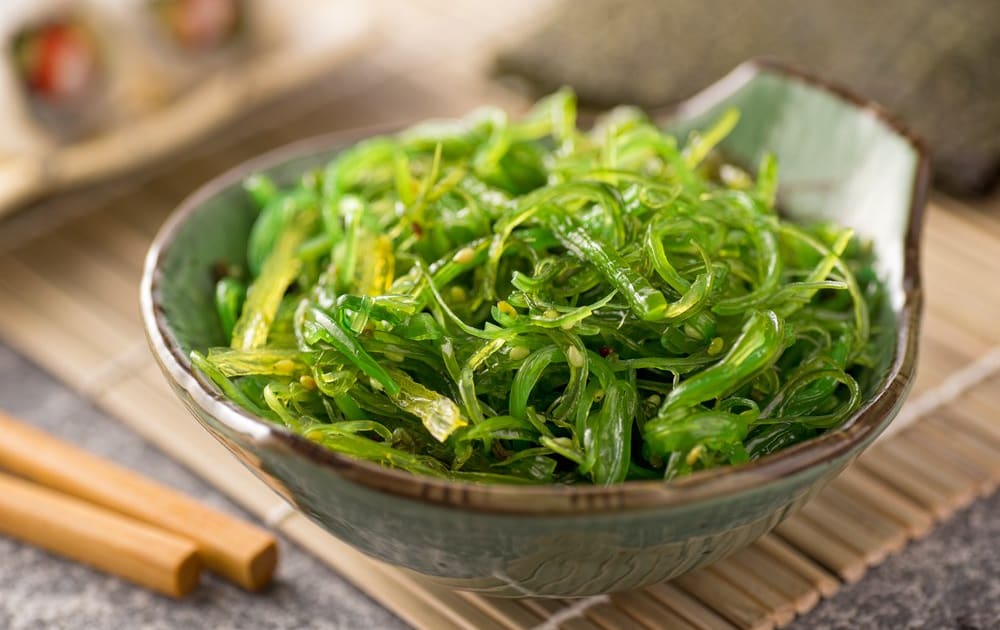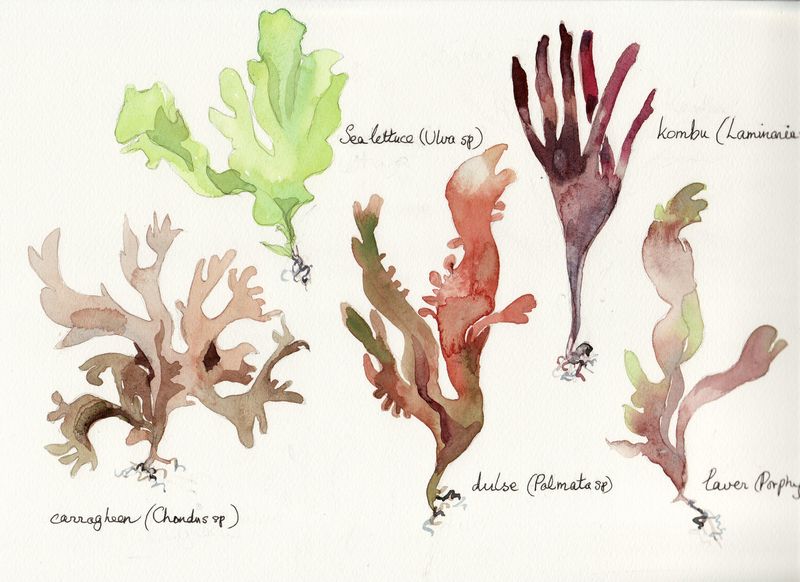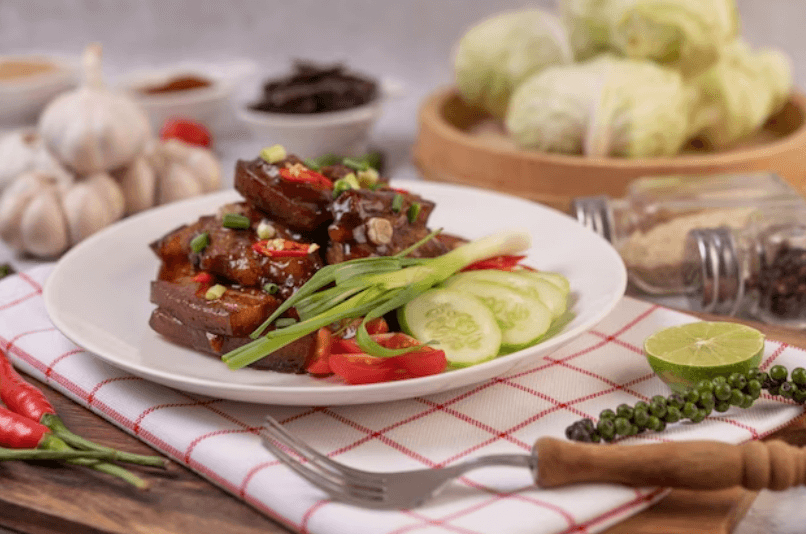A Guide to the Different Types of Seaweeds in Sushi.

Seaweed is an essential ingredient in sushi, adding a unique flavor and texture to this popular Japanese dish. There are several different types of seaweeds commonly used in sushi, each with its own distinct characteristics and benefits. In this guide, we will explore the various types of seaweeds that you might encounter when dining at a sushi restaurant or making sushi at home.
Nori is the most commonly used seaweed in sushi. It is made by shredding and drying the fronds of red algae, resulting in thin, dark green sheets. Nori has a slightly sweet and nutty flavor, and it becomes crispy when toasted. It is often used to wrap sushi rolls, providing a delicious crunch and holding everything together.
Konbu is a type of kelp that is used to make the flavorful broth known as dashi, which forms the base of many Japanese soups and dishes. It has a rich, savory taste and is also used to wrap sushi rice to create a dish called “konbu maki”. Konbu adds an umami flavor to sushi and is especially popular in vegetarian sushi options.
Wakame is a type of edible seaweed that is commonly used in miso soup and seaweed salad. It has a delicate, slightly sweet flavor and a soft, slippery texture. In sushi, wakame is often used as a garnish or a topping, adding a refreshing taste and vibrant color to the dish.
So the next time you enjoy a plate of sushi, take a moment to appreciate the different types of seaweeds that contribute to its delectable taste and texture. Whether it’s the toasted crispness of nori, the savory richness of konbu, or the delicate sweetness of wakame, each seaweed plays an important role in creating the sushi experience we know and love.
A Guide to the Different Types of Seaweeds in Sushi
Sushi is a popular Japanese delicacy that consists of vinegared rice topped or rolled with various ingredients. One of the key components of sushi is seaweed, which adds flavor and texture to each bite. There are several different types of seaweeds commonly used in sushi, each with its own unique characteristics.
One of the most commonly used seaweeds in sushi is nori. Nori is a type of dried seaweed that is typically dark green or black in color. It has a slightly sweet and nutty flavor that complements the other ingredients in sushi. Nori is most commonly used to wrap sushi rolls, providing a crisp, flavorful outer layer.
Another type of seaweed used in sushi is wakame. Wakame is a type of edible kelp that is light green in color and has a delicate, slightly sweet flavor. It is often used in soups and salads, but can also be used as a component in sushi rolls. Wakame adds a refreshing taste and a chewy texture to sushi.
Kombu is another type of seaweed commonly found in sushi. Kombu is a thick, dark brown seaweed that is rich in umami flavor. It is often used to make dashi, a traditional Japanese broth, which is then used as a base for many sushi dishes. Kombu can also be sliced thinly and used as a garnish for sushi rolls.
Lastly, there is hijiki, a type of seaweed that is typically black in color. Hijiki has a strong, earthy flavor and a slightly crunchy texture. It is often used in sushi as a topping or filling, adding a unique taste and texture to the overall dish.
These are just a few examples of the different types of seaweeds commonly used in sushi. Each seaweed brings its own distinctive flavor and texture to the dish, enhancing the overall experience of eating sushi. So next time you enjoy sushi, take a moment to appreciate the wonderful variety of seaweeds that make it possible!
Nori: The Staple Seaweed for Sushi Rolls
Nori is a type of seaweed that is commonly used in sushi rolls. It is the most popular and widely used seaweed in sushi making, making it a staple ingredient in this beloved Japanese dish. Nori is known for its mild flavor and delicate texture, which perfectly complements the other ingredients in sushi.
There are several different types of nori that can be used in sushi. The most common type is called “yakinori,” which is a thin and crispy seaweed that is usually roasted. Yakinori has a rich, umami flavor that adds depth to sushi rolls. Another type is “aonori,” which is a green seaweed that is often used as a topping for sushi rolls. Aonori has a slightly salty and tangy taste, which adds a refreshing contrast to the other ingredients.
When making sushi rolls, nori is typically used to wrap the rice and other fillings. It provides a sturdy and flexible wrapping, keeping the ingredients securely in place. To use nori, simply place it on a bamboo sushi mat, spread a thin layer of sushi rice on top, and add your desired fillings. Roll the mat tightly, using your fingers to hold the ingredients together, and you will have a delicious sushi roll ready to be enjoyed!
Not only is nori a tasty addition to sushi, but it also offers health benefits. Nori is packed with essential nutrients, including vitamins A, C, and B12, as well as minerals like iodine and iron. It is low in calories and fat, making it a nutritious choice for those watching their weight.
In conclusion, nori is the staple seaweed for sushi rolls. Its mild flavor and delicate texture make it the perfect complement to the other ingredients. Whether it’s the crispy yakinori or the tangy aonori, nori adds a unique taste to sushi rolls. So the next time you enjoy sushi, take a moment to appreciate the nori that holds it all together!
Kombu: The Umami Enhancer in Sushi Broths
When it comes to seaweeds used in sushi, there are several different types to choose from. One of the most popular and widely used varieties is kombu.
Kombu is a type of kelp that is harvested in the waters off the coast of Japan. It is known for its rich umami flavor, which is one of the five basic tastes along with sweet, sour, bitter, and salty.
Umami is often described as a savory or meaty taste, and kombu is able to enhance the umami taste in dishes when added to broths or stocks. It is commonly used as a key ingredient in making dashi, a traditional Japanese broth that is the foundation of many soups, sauces, and other dishes.
Kombu is not only valued for its taste, but also for its nutritional benefits. It is high in vitamins and minerals, including iodine, calcium, and iron. It is also a good source of dietary fiber and is low in calories.
In addition to being used in sushi broths, kombu can also be used to wrap sushi rolls or as a garnish for rice dishes. It can be rehydrated and cooked in various ways, making it a versatile ingredient in Japanese cuisine.
Next time you enjoy a bowl of miso soup or a plate of sushi, remember the important role that kombu plays in enhancing the flavors of these dishes. Its unique umami taste and nutritional benefits make it a valuable ingredient in sushi broths and other Japanese recipes.
Wakame: The Delicate Seaweed in Miso Soup
When it comes to sushi, there is a guide to the different types of seaweeds that can be found in this popular Japanese dish. One of the most commonly used seaweeds in sushi is wakame. While wakame can be used in various sushi dishes, it is especially popular in miso soup.
Wakame is a delicate seaweed that is known for its thin, smooth texture and mild flavor. It is usually dark green or brown in color and is typically sold dried. This makes it easy to store and prepare for culinary use.
The process of using wakame in miso soup is quite simple. First, the dried wakame needs to be rehydrated by soaking it in water. Once the seaweed is soft and pliable, it can be added to the miso soup along with other ingredients such as tofu, green onions, and mushrooms.
Wakame not only adds a unique texture to miso soup but also brings a wealth of nutritional benefits. It is rich in essential vitamins and minerals, including calcium, iron, and iodine. Additionally, it contains antioxidants and is known for its detoxifying properties.
- The delicate texture and mild flavor of wakame make it a perfect addition to miso soup.
- Wakame is typically sold dried, making it convenient to store and use.
- Rehydrating wakame is a simple process that involves soaking it in water.
- Wakame is rich in essential vitamins, minerals, and antioxidants.
In conclusion, wakame is a delicate seaweed that is commonly used in miso soup. Its thin texture and mild flavor make it a perfect addition to this traditional Japanese dish. Not only does wakame enhance the taste and appearance of miso soup, but it also provides numerous health benefits. So next time you enjoy a bowl of miso soup, take a moment to appreciate the delicate wakame seaweed that adds so much to this beloved dish.
Hijiki: The Nutrient-rich Seaweed with Earthy Flavor
Hijiki is one of the many seaweeds commonly used in sushi. Known for its earthy flavor, this nutrient-rich seaweed adds a unique touch to various sushi dishes.
As part of our guide to the different types of seaweeds in sushi, it is important to highlight the benefits of including hijiki in your diet. Hijiki is packed with essential vitamins and minerals, making it a great addition to a healthy lifestyle.
One notable nutrient found in hijiki is iodine, which plays a vital role in maintaining a healthy thyroid function. Additionally, hijiki is also rich in calcium, iron, and magnesium, all of which are important for bone health and overall well-being.
When it comes to taste, hijiki has a distinct earthy flavor that pairs well with many sushi ingredients. Its texture is slightly chewy, adding an interesting contrast to the sushi roll. Hijiki can be used in various sushi rolls, such as vegetarian rolls or mixed with other seafood for a more diverse flavor profile.
Whether you are a sushi enthusiast or simply looking to explore different flavors, hijiki is definitely worth trying. Its nutrient-rich properties, along with its unique earthy flavor, make it a valuable addition to any sushi dish.
Arame: The Mild Seaweed with a Slight Sweetness
Arame is a type of seaweed that is commonly used in sushi. It is known for its mild flavor and slight sweetness, making it a popular choice for many sushi lovers.
This variety of seaweed is harvested along the coast of Japan, where it grows abundantly in the cold waters of the Pacific Ocean. It is then dried and packaged for use in sushi and other dishes.
One of the reasons arame is so beloved in sushi is because of its delicate texture. It is thin and tender, making it easy to eat and enjoy. The slight sweetness adds a pleasant contrast to the other flavors in sushi, enhancing the overall taste of the dish.
Not only is arame delicious, but it also offers a variety of health benefits. It is rich in vitamins and minerals, including iodine, calcium, and potassium. These nutrients are essential for maintaining a healthy body and can help support proper thyroid function.
When preparing arame for sushi, it is typically rehydrated by soaking it in water for a few minutes. This softens the seaweed and brings out its natural flavors. It can then be added to sushi rolls, nigiri, or used as a garnish.
Next time you’re enjoying sushi, be sure to try arame. Its mild flavor and slight sweetness are sure to delight your taste buds and add a unique element to your sushi experience.
Dulse: The Red Seaweed with a Smoky Flavor
When it comes to sushi, there are many different types of seaweeds that can be used to wrap the delicious ingredients. One such type is dulse, a red seaweed with a distinctive smoky flavor.
Dulse is commonly found in the Atlantic Ocean, particularly along the coasts of Canada and the northern regions of Europe. It has been a staple in the diet of these regions for centuries and is now gaining popularity worldwide.
What sets dulse apart from other types of seaweeds is its unique taste. The smoky flavor of dulse adds a depth and richness to any sushi roll. It is often used to wrap ingredients like crab, avocado, and cucumber, complementing their flavors and adding a touch of umami.
In addition to its flavor, dulse also boasts an impressive nutritional profile. It is packed with vitamins, minerals, and antioxidants, making it a healthy choice for sushi lovers. Dulse is rich in iodine, which is essential for proper thyroid function, as well as iron, calcium, and vitamin C.
Preparing dulse for sushi is quite simple. Start by rinsing it under cold water to remove any sand or debris. Then, soak it in cold water for about 10 minutes to soften it. Once it’s soft, drain the water and pat the dulse dry with a paper towel. Finally, you can cut it into strips and use it to wrap your favorite sushi ingredients.
So the next time you’re enjoying sushi, don’t forget to try dulse. Its smoky flavor and nutritional benefits make it a great addition to any sushi roll. Whether you’re a sushi enthusiast or just starting to explore this culinary delight, dulse is definitely worth a try.
Agar: The Gelatinous Seaweed Used in Sushi Desserts
When it comes to making sushi, there are many different types of seaweeds that can be used. One of the most important and versatile seaweeds used in sushi is agar. Agar is a gelatinous substance derived from red seaweed, and it is often used as a thickening agent in desserts.
Agar is known for its unique texture and ability to form a gel when dissolved in water. This makes it ideal for creating a variety of sushi desserts, such as agar pudding or jelly. The gel-like consistency of agar gives these desserts a smooth and silky texture that is both refreshing and satisfying.
Agar is also prized for its ability to maintain its shape even at high temperatures. This makes it perfect for molding into various shapes and designs, allowing sushi chefs to showcase their creativity and artistry. Whether it’s a simple square or a complex decorative shape, agar can hold its form and add an element of visual appeal to sushi desserts.
Not only is agar versatile and aesthetically pleasing, but it also has health benefits. Agar is low in calories and fat, making it a healthier alternative to traditional gelatin-based desserts. It is also rich in fiber and minerals, such as iodine and calcium, which are essential for maintaining a balanced diet.
Next time you indulge in sushi desserts, take a moment to appreciate the gelatinous wonder that is agar. Its unique texture, versatility, and health benefits make it a beloved seaweed in the world of sushi. So go ahead, try a bite of agar pudding or jelly, and experience the delightful combination of taste and texture that it brings.
Sea Lettuce: The Soft and Mild Seaweed in Salads
In the world of seaweeds, sea lettuce is one of the most popular and versatile options. With its soft texture and mild flavor, sea lettuce is the perfect seaweed to add to salads.
Sea lettuce is known for its vibrant green color, which adds a fresh and vibrant element to any dish. It is usually sold in dried form and can be rehydrated before use. Once rehydrated, sea lettuce becomes soft and pliable, making it easy to incorporate into salads.
Sea lettuce has a mild and slightly salty taste, which pairs well with a variety of ingredients. It adds a subtle umami flavor to salads without overpowering other flavors. The texture of sea lettuce is also quite delicate, adding a tender and velvety aspect to salads.
When using sea lettuce in salads, it’s important to keep in mind that it can easily become too soft and lose its texture if soaked for too long. It’s best to rehydrate sea lettuce just before using it and then drain it well to remove any excess moisture.
As for salad pairings, sea lettuce goes well with a range of ingredients. It complements fresh vegetables like cucumbers, tomatoes, and carrots, as well as proteins like grilled chicken or tofu. It can also be combined with other seaweed varieties to create a dynamic and flavorful salad.
With its soft texture, mild flavor, and vibrant green color, sea lettuce is an excellent choice for adding a touch of the ocean to your salads.
Mozuku: The Unique and Refreshing Seaweed from Okinawa
When it comes to the different types of seaweeds used in sushi, Mozuku holds a special place. Originating from the beautiful island of Okinawa, Mozuku is a unique and refreshing seaweed that adds a burst of flavor to any sushi dish.
Known for its vibrant green color and long, thin strands, Mozuku is often used in vinegared salads or served as a side dish in traditional Okinawan cuisine. Its distinct texture and mild, briny taste make it a sought-after ingredient in sushi restaurants around the world.
Mozuku seaweed is harvested in the waters surrounding Okinawa and is known for its natural sweetness and high nutritional value. Rich in dietary fiber, vitamins, and minerals, Mozuku is not only delicious but also incredibly healthy.
One of the reasons why Mozuku is so prized is its refreshing taste. It has a unique umami flavor that perfectly complements the delicate flavors of sushi. Its slightly crunchy texture adds an interesting contrast to the softness of the sushi rice and the melt-in-your-mouth fish.
Whether you’re a sushi lover or looking to try something new, Mozuku is definitely worth a try. Its unique and refreshing taste will transport you to the beautiful beaches of Okinawa, and its health benefits will leave you feeling nourished and satisfied.
So, next time you’re enjoying a sushi roll, don’t forget to ask for a dash of Mozuku. You won’t be disappointed!
Umibudo: The “Green Caviar” Seaweed with Bursting Texture
Umibudo, also known as “green caviar”, is one of the different types of seaweeds that can be found in sushi. It is a unique type of seaweed that originates from Okinawa, Japan, and is gaining popularity all around the world.

Umibudo has earned its nickname “green caviar” due to its appearance and texture. The small, vibrant green bubbles that make up this seaweed resemble tiny caviar beads, giving it an elegant and luxurious look. When you bite into it, umibudo bursts in your mouth, releasing a refreshing and slightly salty taste.
As umibudo is commonly used in sushi, it adds a delightful crunchiness and enhances the overall flavor of the dish. Its unique texture and taste make it a favorite among sushi lovers who enjoy experiencing different flavors and textures in their rolls.
This seaweed is not only delicious but also has numerous health benefits. Umibudo is rich in essential minerals like calcium, iron, and iodine. It is also low in calories and high in fiber, making it a nutritious addition to your sushi.
When preparing umibudo for sushi, it is typically served fresh and raw. It is often combined with other ingredients such as fish, vegetables, or rice to create a harmonious and flavorful combination.
Next time you visit a sushi restaurant, be sure to look out for umibudo on the menu. Its unique appearance, bursting texture, and refreshing taste make it an exciting addition to any sushi experience. Try it for yourself and discover why umibudo is often referred to as the “green caviar” of seaweed!
Sargassum: The Gourmet Seaweed in High-End Sushi
When it comes to types of seaweeds used in sushi, Sargassum is considered a gourmet option that is often found in high-end sushi restaurants. Known for its unique flavor and texture, Sargassum adds a special touch to sushi rolls, making them a delicacy for sushi enthusiasts.
Sargassum, also known as Sargassum horneri or Japanese wireweed, is a type of brown seaweed that is native to the waters of Japan. It is typically harvested in the spring and summer months when it is at its peak freshness. Its vibrant green color and delicate, feathery appearance make it visually appealing when used as a garnish or wrap for sushi rolls.
One of the key characteristics of Sargassum is its umami taste, which is often described as deep, savory, and earthy. This unique flavor profile enhances the overall taste of sushi, complementing other ingredients such as fish, rice, and soy sauce. Its slightly crunchy texture provides a pleasant contrast to the softness of the rice and the smoothness of the fish, creating a delightful eating experience.
In addition to its excellent taste and texture, Sargassum is also packed with nutrients. It is rich in vitamins A, C, and E, as well as minerals like calcium and iron. As a result, Sargassum not only adds flavor to sushi but also provides a healthy dose of essential nutrients.
Overall, Sargassum is a gourmet seaweed that elevates the sushi dining experience. Its unique flavor, delicate appearance, and nutritional benefits make it a popular choice among sushi connoisseurs. So, the next time you visit a high-end sushi restaurant, be sure to look out for Sargassum and indulge in the gourmet experience it offers.
Sea Grapes: The Crunchy Seaweed with a Hint of Saltiness
When it comes to sushi, there are many different types of seaweeds that are used to wrap the delicious rolls. One of the lesser-known seaweeds is sea grapes. Sea grapes, also known as green caviar or umi budo, are small, spherical seaweed that are native to the waters of Asia.
Sea grapes have a unique texture that is crisp and slightly crunchy, making them a popular choice among sushi enthusiasts. The seaweed is also known for its hint of saltiness, which adds another layer of flavor to the sushi roll.
In addition to their delicious taste, sea grapes are also packed with nutrients. They are a good source of vitamins A and C, as well as calcium and iron. They are also low in calories, making them a healthy addition to any sushi roll.
Sea grapes are typically used as a garnish in sushi rolls, adding both visual appeal and a burst of flavor. They can also be enjoyed on their own as a snack or used in other dishes, such as salads or soups.
If you’re looking to try something new and exciting in your sushi, give sea grapes a try. Their crunchiness and hint of saltiness are sure to add a unique twist to your sushi experience.
Irish Moss: The Seaweed with Thickening Properties for Vegan Sushi
When it comes to sushi, there are many types of seaweeds used to create those delicious rolls. One of the lesser-known seaweeds used in sushi is Irish Moss. Although not as common as nori or wakame, Irish Moss brings its own unique qualities to vegan sushi.
Irish Moss is a red seaweed that is native to the Atlantic coastlines of Europe and North America. It is known for its ability to thicken liquids, making it a perfect addition to vegan sushi recipes. When Irish Moss is soaked and blended, it creates a gel-like substance that can be used as a natural thickening agent in sauces, dressings, and even sushi fillings.
Not only does Irish Moss provide thickening properties, but it also adds a unique texture to vegan sushi. When added to sushi rice or fillings, it creates a slightly chewy and gelatinous texture that enhances the overall eating experience.
Irish Moss is also a great source of nutrients. It is rich in dietary fiber, iron, and vitamins A and K. Including Irish Moss in your vegan sushi not only adds flavor and texture but also boosts the nutritional value of your meal.
When using Irish Moss in sushi, it is important to properly prepare it to ensure its thickening properties. Start by rinsing the Irish Moss under cold water to remove any sand or debris. Then, soak it in a bowl of cold water for about 10 minutes. After soaking, drain the water and blend the Irish Moss with fresh water until it forms a smooth gel-like consistency. Once ready, you can add it to your sushi rice or fillings as desired.
So next time you’re exploring different types of seaweeds for your sushi creations, don’t forget to give Irish Moss a try. Its thickening properties and unique texture are sure to elevate your vegan sushi to a whole new level.
Codium: The Sponge-like Seaweed with a Briny Taste
When it comes to sushi, there are many different types of seaweeds that can be used to wrap the delicious rolls. One of the most unique and interesting types of seaweed used in sushi is Codium.
Codium is a green seaweed that has a sponge-like texture and a salty, briny taste. It is commonly used in sushi to add a crunchy texture and a burst of ocean flavor.
Unlike some other types of seaweeds used in sushi, Codium does not need to be rehydrated before it can be used. It can be added directly to the sushi roll, making it a convenient and easy option for sushi chefs.
In addition to its use in sushi, Codium is also used in various other dishes. It can be stir-fried, pickled, or even used in salads. Its unique texture and flavor make it a versatile ingredient that can add a unique twist to any dish.
Next time you’re enjoying sushi, be sure to try a roll that features Codium seaweed. Its sponge-like texture and briny taste are sure to delight your taste buds!
Q&A:
What are the different types of seaweeds used in sushi?
Sushi can be made with various types of seaweeds, including nori, kombu, and wakame. Nori is the most commonly used seaweed for wrapping sushi rolls, while kombu is often used to make dashi, a type of soup stock. Wakame is frequently used in salads and as a garnish.
What is nori?
Nori is a type of seaweed that is used to wrap sushi rolls. It is dried and pressed into thin sheets that have a slightly salty taste. Nori is often toasted before being used in sushi to enhance its flavor.
How is kombu used in sushi?
Kombu, a type of kelp, is primarily used to make dashi, a Japanese soup stock. It adds a subtle umami flavor to the broth. Kombu can also be used to flavor rice or as an ingredient in salads.
What is wakame?
Wakame is a type of seaweed that is commonly used in Japanese cuisine. It has a slightly sweet and briny flavor. Wakame is often used in salads, miso soup, and as a garnish for various dishes.





